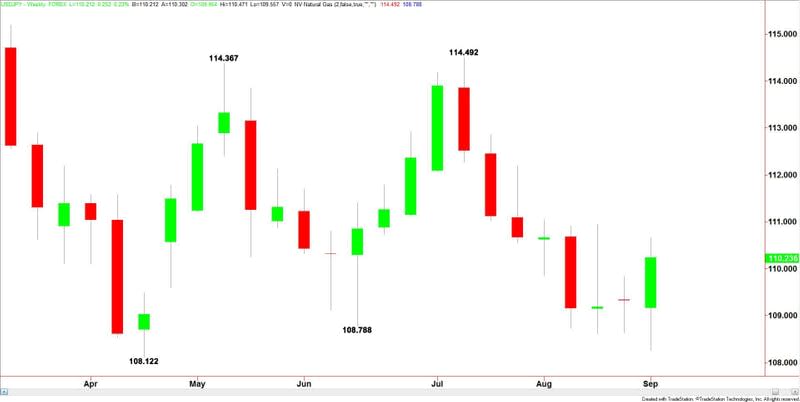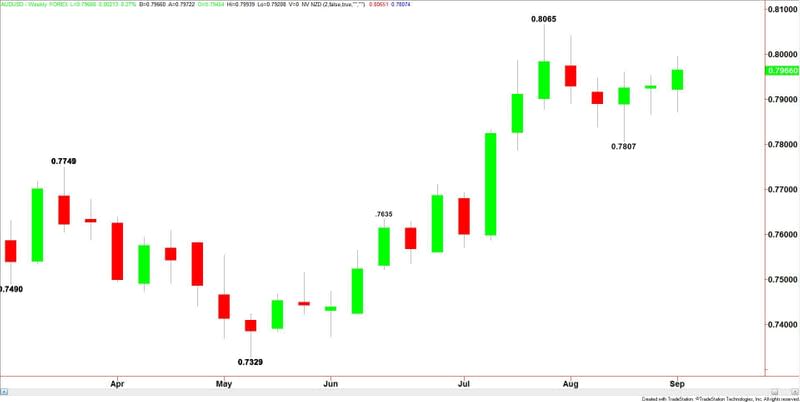U.S. Dollar Index Whip-sawed but Still Finishes Week Higher
The U.S. Dollar Index posted a wild, two-sided trade last week before closing higher for the week. Sellers dominated the trade early in the week as flooding caused by Hurricane Harvey paralyzed Houston, Texas, the nation’s fourth-biggest city, and drove worries about a hit to the economy.
September U.S. Dollar Index futures settled the week at 92.769, up 0.092 or +0.10%.

The dollar was already in a weak position at the start of the week because on the previous Friday, U.S. Federal Reserve Chair Janet Yellen failed to mention monetary policy at her closely watched Jackson Hole meeting in Wyoming. Investors interpreted this to mean that Yellen was comfortable with the Fed’s rate hike expectations. Currently, the market has priced in only one by the end of next year.
A strong Euro also weighed on the U.S. Dollar. It rose to a 2 ½ year high over $1.20, extending its gains from the previous week after European Central Bank President Mario Draghi refrained from talking down the buoyant currency at the same meeting.
The Greenback was also pressured by flight-to-safety buying after North Korea launched a ballistic missile over Japan’s northerly island of Hokkaido. However, the dollar index mounted a strong recovery after U.S. 10-year Treasury yields pulled up from a 9-month low.
The dollar was further supported at mid-week after strong U.S. economic data bolstered expectations for a solid U.S. jobs report later this week. The greenback gained after the U.S. Commerce Department revised up gross domestic product to a 3.0 percent annual rate in the second quarter, the quickest in more than two years.
On Thursday, the dollar slipped from its high for the week after unimpressive U.S. economic data failed to boost expectations for another rate increase later this year. According to the Commerce Department, consumer spending came in below expectations and the personal consumption expenditures (PCE) price index excluding food and energy or “core PCE” price index increased 1.4 percent, the smallest gain since December 2015.
Finally, on Friday, the U.S. released a disappointing Non-Farm Payrolls report that weighed on the chances of a Fed rate hike. The Non-Farm Employment Change was 156K versus an estimate of 180K. The previous month was also revised lower to 189K. The unemployment rate rose to 4.4%, up from 4.3% and Average Hourly Earnings rose only 0.1% versus a 0.2% estimate.

Japanese Yen
The Dollar/Yen closed higher for the week after posting a volatile two-sided trade. The wild price action was driven at times by safe haven buying and selling, two-sided swings in U.S. Treasury yields and multiple changes in investor sentiment.
The USD/JPY finished the week at 110.236, up 0.913 or 0.84%.
The Forex pair lost ground when Korea launched its missile over Japan, but a recovery in U.S. Treasury yields helped give it a boost. A strong stock market rally helped boost investor sentiment which drove the Japanese Yen lower because of the carry trade. Even though the U.S. jobs report was disappointing, it did not eliminate the chances of a Fed rate hike. This also helped underpin the Dollar/Yen.

Australian Dollar
The Australian Dollar also posted a two-sided trade last week. It weakened when U.S. Treasury yields rose as the spread between U.S. Treasury Bonds and Australian Government Bonds tightened. And it strengthen when U.S. stocks rallied due to increased demand for higher-yielding assets. It was also supported late in the week by the disappointing U.S. jobs report.
The AUD/USD settled the week at .7966, up 0.0035 or +0.45%.
The only major economic report was Private Capital Expenditures. They rose more than expected by 0.8%. Some of the buying may have also been related to position-squaring ahead of next week’s Reserve Bank of Australia’s interest rate decision and monetary policy statement.

New Zealand Dollar
At times last week, the New Zealand Dollar was driven by U.S. Treasury yields, but the overall trend was driven by comments from Reserve Bank of New Zealand Governor Graeme Wheeler.
The NZD/USD settled the week at .7154, down 0.0085 or -1.18%.
The New Zealand Dollar weakened after Wheeler said that a lower New Zealand Dollar was needed to help bolster the export sector and push up inflation. Wheeler also said there was a risk the housing market would take off again if the central bank removed its loan-to-value lending restrictions (LVRs), amid political pressure to rethink their use.
“The appreciation in the exchange rate has been a headwind for the tradables sector and, by reducing already weak tradables inflation, made it more difficult to reach the Bank’s inflation goals,” Wheeler said.
This article was originally posted on FX Empire
